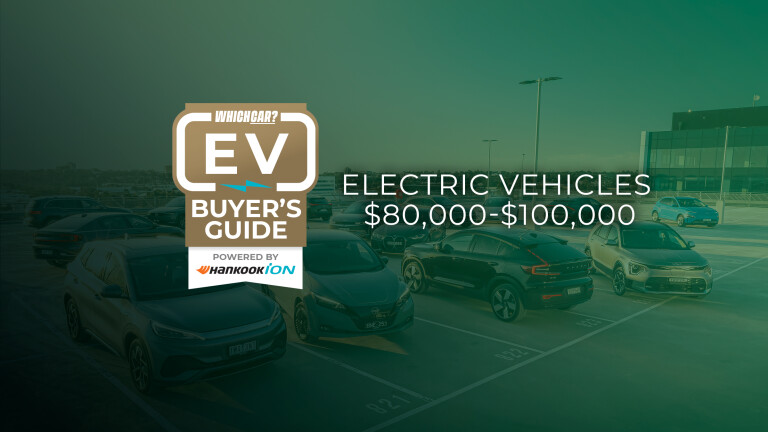
Welcome to our EV Buyer's Guide: Electric Vehicles priced from $80,000 to $100,000 – The Best and The Rest
It's new cars galore in the top segment of our EV Megatest series.
Among them is the latest i-badged model from BMW – the i4 sedan, a direct rival to the likes of the Tesla Model 3 Performance and Polestar 2 Dual-Motor.
The Volvo C40 is a coupe-style spin-off of the XC40, though unlike its donor is available only in electric form.
Mercedes-Benz continues to ramp up its EV offerings and the latest is the EQB – the electric variant of the GLB seven-seater SUV range.
In this group, it joins a newer, more powerful version of the three-pointed-star’s GLA-based EQA baby electric SUV – the 350.
Our quintet is completed by Lexus’s first ever battery electric vehicle, the UX300e crossover.
JUMP AHEAD
- BEST BUY: BMW i4 eDrive40
- $99,900 + on-road costs
- mid-size sedan
- single-motor RWD, 84kWh battery
- 520km range, 200kW fast charge
- Highly recommended: Volvo C40 Recharge
- $82,490 + on-road costs
- small SUV
- dual-motor AWD, 75kWh battery
- 420km range, 155kW fast charge
- Highly recommended: Mercedes-Benz EQB250
- $87,800 + on-road costs
- medium SUV
- single-motor FWD, 66.5kWh battery
- 371km range, 100kW fast charge
- Mercedes-Benz EQA 350
- $101,800 + on-road costs (see note)
- Small SUV
- Dual-motor AWD, 65.5kWh battery
- 400km range, 100kW fast charge
- Lexus UX300e
- $80,691 + on-road costs
- Compact SUV
- Single-motor FWD, 54.4kWh battery
- 315km range
- VERDICT 🏆
- COMING SOON: Charging and driving range tested

2022 BMW i4 eDrive40
Cameron Kirby
BMW’s i4 40 eDrive may be the cheapest variant in its two-strong range, but it is the most expensive contender in our megatest – just scraping under the cost cap with a $99,900 sticker price before on-roads and options.
| Things we like | Not so much |
|---|---|
| Superb refinement | Slightly hindered rear headroom |
| Impressive charging | Options jump it into six figures |
| Compelling driving dynamics | Some features require a subscription |
But under is under, and the i4 proves that stretching the budget can sometimes reap bountiful rewards. For those that have come accustomed to EVs having an air of strangeness for strangeness’ sake, the i4 is a breath of fresh air. Traditional in all the best ways, it is an EV for the powertrain agnostic.
If you didn’t want to fall too far into the six-figure range once on-roads are factored in, the i4 40 eDrive still has plenty of standard kit including 19-inch alloys, leather interior, auto LED headlights, head-up display, adaptive suspension, auto parking, keyless entry and start, front, side and reversing cameras, auto wipers, three-zone climate control, electric front seat adjustment, a powered tailgate, digital dashboard and a tyre repair kit.
The infotainment and digital instrument cluster (14.0-inch and 12.3-inch respectively) are cohesively paired as a seemingly single unit and operate with BMW’s eighth generation iDrive system.
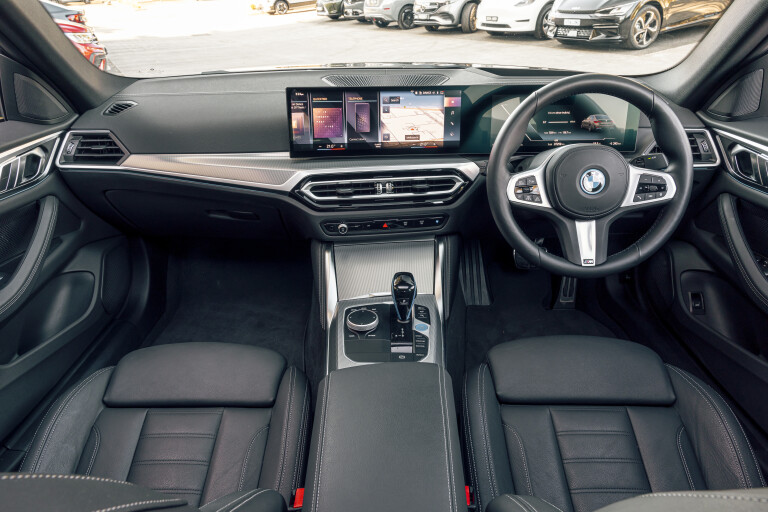
It is intuitive to navigate through either touch, rotary dial, or gesture controls. However you only get wireless Apple CarPlay and Android Auto, sat-nav, and digital radio for free during the first three years of ownership, after which a subscription fee kicks in.
The i4 does have one tripping point, however: while its ICE cousin the 4 Series has a 5-star ANCAP safety rating – awarded under less-strict criteria in 2019 – the i4 was given a shock 4-star rating in February 2023, due to an unimpressive active safety suite. You can read about that here, but the short version is that the i4's NCAP testing was carried out in Europe, whereas BMW Australia insists the car's Aus-market active safety systems are of a "higher standard" than what's fitted as standard in Europe.
ANCAP says it could not verify this, however, because "BMW did not put the vehicle forward to ANCAP for verification testing to confirm performance of these systems".
(Note: this ANCAP score was announced after we completed this assessment and ranking.)
In Australia, the i4 comes equipped with six airbags, forward auto emergency braking, steering and lane control assist, lane-keep assist, lane departure warning, lane change warning, forward and rear cross-traffic alert, crossroad warning and evasion assistant as standard.
Being based on the regular 4 Series Gran Coupe, the i4 inherits that model’s traditional sedan proportions, as well as the platform’s ICE roots. While doing away with unnecessary oily bits such as a fuel tank along with the traditional transmission and differential, the i4’s rear seats are actually slightly higher to accommodate batteries.
This has a small impact on rear headroom, but it’s not a dealbreaker, and there is still plenty of space for adults to ride in the rear – though the centre seat is worthless so if you want five-up accommodation look elsewhere.
BMW has fitted this entry-level i4 with an 84kWh battery, which has a useable capacity of 81kWh. Despite its claimed maximum DC charging rate being less than others in this field, the i4 was the second-quickest charger behind the Tesla Model 3.
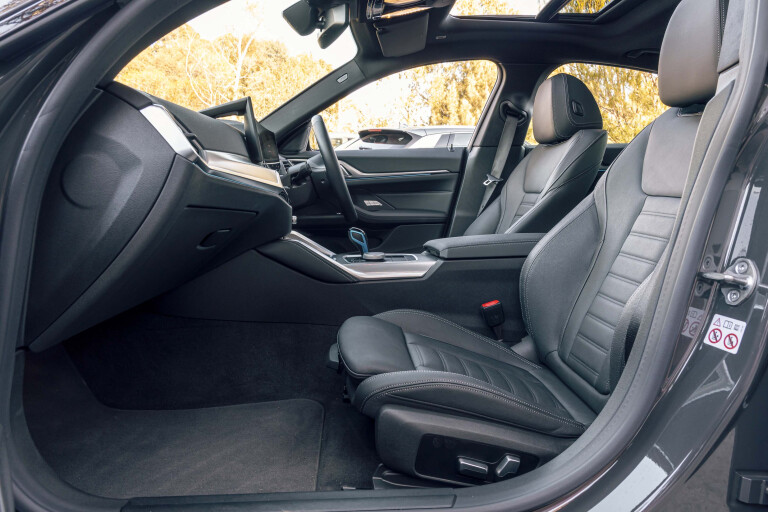
It is also worth noting that the displayed range on the i4’s instrument cluster is pessimistic compared to the real-world capability we experienced during testing. A boon for owners is the ability to tweak and schedule the i4’s charging parameters, meaning you can cap how much energy you want to put into the batteries, and make the most of off-peak electricity prices.
Owners are also gifted five years of free charging on the Chargefox network, which is comprehensive and ever-growing.
We were seriously impressed by the i4 on our road testing loop, where it exemplified the BMW driving experience in the best of ways. Composed, planted, refined and unimposing, it is an EV for those that enjoy time behind the wheel.
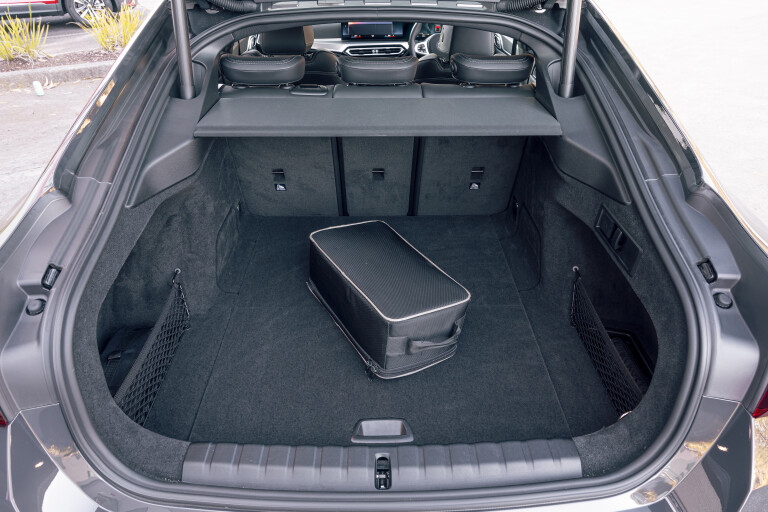
A newly announced five years/unlimited kilometre overall warranty dovetails nicely with the eight years/160,000kms battery warranty. BMW also offers a pre-paid service plan with condition-based servicing in four or six year packages. A four-year plan is $1240, or $310 per year and six years is $1765 or $294 per year.
Unlike many competitors in this segment the BMW i4 doesn’t shout about its electric powertrain from the rooftops. Other than its solid grille it remains visually indistinguishable from ICE counterparts, and holds itself with the same self-assured confidence. Want and EV without the quirks? Walk this way.
SCORING: BMW i4 eDrive40
| OVERALL | 9 |
|---|---|
| Safety, value and features | 8 |
| Comfort and space | 8 |
| Engine and gearbox | 9.5 |
| Ride and handling | 9.5 |
| Technology | 9.5 |
Specifications
| 2022 BMW i4 40 eDrive | ||
|---|---|---|
| Price | $99,900 + on-road costs | |
| Size & segment | mid-size sedan | |
| Seats | 5 | |
| Boot space min/max | 470L/1290L | |
| Drive | single-motor RWD | |
| Battery size | 81kWh | |
| Outputs | 250kW/430Nm | |
| Efficiency | 15.77kWh/100km | |
| Driving range | WLTP | Tested |
| 520km | 513km | |
| Charging speed | Claimed | Tested |
| DC fast charging | 205kW, 10-80% 31 min | 68.8kW/h, 62-100% 31 min |
| AC home charging | 11kW, 0-100% 8.25 hours | not tested |
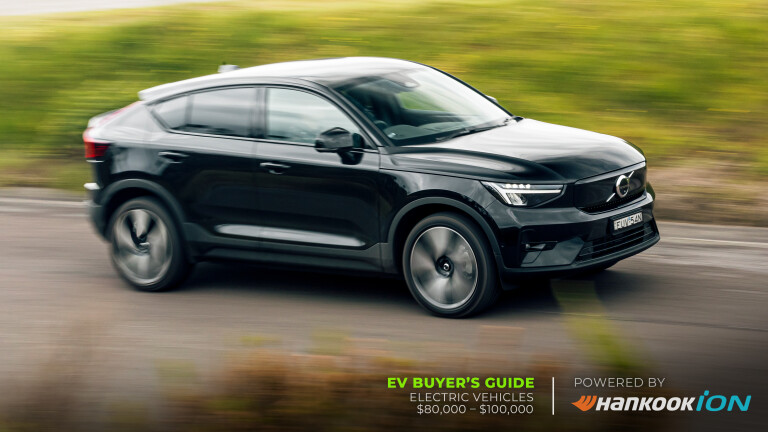
2022 Volvo C40 Recharge Twin
Volvo’s first electric-only model weighs in with Swedish style, playful performance and a price.
| THINGS WE LIKE | NOT SO MUCH |
|---|---|
| Interior presentation | Relatively expensive |
| Superior ride and handling | No auto wipers |
| Excellent all-round performance | Little rear-seat thigh support |
Volvo’s recent announcement that it intends to only sell electric vehicles in Australia by 2026 has created a lot of work for the Swedish brand and it now has about four years to rid its five-model line-up of petrol power. That’s no easy feat but, actually, it’s already started.
It’s XC40 and XC90 SUVs are currently offered (pun intended) as Recharge pure EVs, while the arrival of this car grows the family to six models. The significant thing about the C40 though, is it’s only available as an EV. This is the shape of the future for Volvo.
With a more coupe-like profile, the C40 is following a trend into less orthodox SUV styling, offering essentially a version of the XC40 that shares virtually all the mechanicals, but there are some other differences including the price. While the C40 range kicks off from $74,990 the longer range all-wheel drive version we have here costs $82,490 and that’s $2500 more than the equivalent XC40.

But there’s another EV that’s mechanically closely related to the C40. Even though the Polestar 2 takes the same CMA platform and is available with the same three choices of powertrain, the equivalent version costs just under $70,000 and that makes the Volvo appear a bit pricey.
That said, the C40 still undercuts some other premium offerings including equivalent versions of the Mercedes-Benz EQA and Tesla Model Y. For the cash, Volvo is offering a decent chunk of equipment wrapped up in a package that’s beautifully designed inside and out.
A 9.0-inch touchscreen featuring an operating system jointly developed with Google, digital instruments, wireless charging pad, panoramic roof, heated electrically adjustable seats, electric tailgate and dual-zone climate control are all included in the asking price, as is a full suite of active safety tech.
That covers autonomous emergency braking (forward & reverse), adaptive cruise control, lane-keep assist, blind-spot monitoring, cross-traffic alert, parking sensors all round, reversing camera, rain-sensing wipers and hill descent control for a little off-road promise.

As this is the top-shelf version though, the Twin adds to that list with a posh Harman Kardon stereo, 20-inch wheels, 360-degree camera and its differentiating powertrain.
With an extra driven axle, the C40 Recharge Twin has a peak power output of 300kW and 660Nm as well as all-wheel drive. The powertrain is fed by a 75kWh lithium ion battery that’ll hold enough power to take the Volvo up to 100km/h from standstill in 4.7 seconds and a distance of up to 420km.
Performance, as you might expect, is effervescent but Rolling acceleration feels even more aggressive than off-the-mark with a cleverly calibrated throttle that damps big inputs at low speed for smoother driving and lively responsiveness when up and moving.
Rather than opting for the weight-taming stiffness that many other battery-powered models adopt along with the crashy ride that often comes with it, this Volvo is softly sprung and is impressively comfortable on bad roads.

There’s more body roll as a consequence but in a trade-off between relaxation and stimulation, we’d take the Volvo most days. That’s not to say the C40 is lacklustre on challenging roads because when the way ahead turns gravelly and damp, the Volvo’s traction is as impressive as the level of driver involvement.
And all the time occupants are immersed in a wonderfully tasteful presentation of classy Swedish design. Cool topography inspired door trims are backlit at night, high-quality materials look far more premium than their recycled origin would suggest, while a huge panoramic roof and all-digital displays up front complete the luxurious cabin.
In the back stalls there’s also more room for passengers than the more coupe roofline promises and reasonable seat comfort except for a little lacking under-thigh support.
With performance, range a pricing that falls pretty squarely in the most competitive part of the growing EV market, the Volvo C40 might have been in danger of blending into the background, but its clever features and charming contemporary design allow it to keep its head above the crowd.
SCORING: Volvo C40 Recharge Twin
| OVERALL | 8.1 |
|---|---|
| Safety, value and features | 7.5 |
| Comfort and space | 8 |
| Engine and gearbox | 8 |
| Ride and handling | 8.5 |
| Technology | 8.5 |
Specifications
| 2022 Volvo C40 Recharge Twin | ||
|---|---|---|
| Price | $82,490 + on-road costs | |
| Size & segment | small SUV | |
| Seats | 5 | |
| Boot space min/max | 489L/1205L | |
| Drive | dual-motor AWD | |
| Battery size | 75kWh | |
| Outputs | 300kW/660Nm | |
| Efficiency | 21.4kWh/100km | |
| Driving range | Claimed | Tested |
| 420km | 350km | |
| Charging speed | Claimed | Tested |
| DC fast charging | 155kW | 47.1kW, 45-100% 55 min |
| AC home charging | 11kW | not tested |
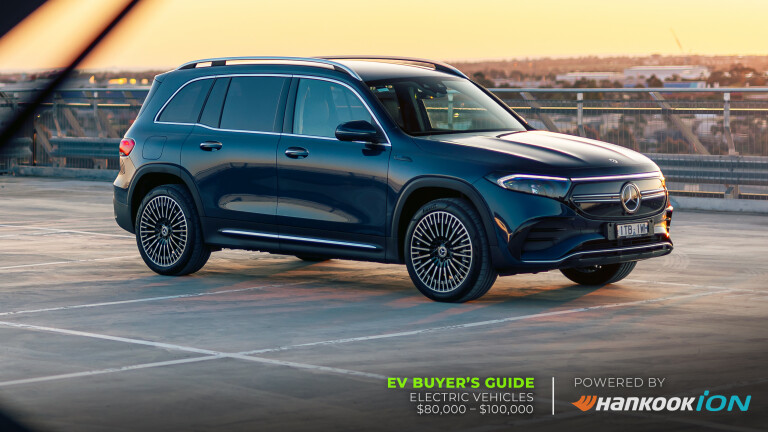
2023 Mercedes-Benz EQB250
Mercedes-Benz’s mid-size BEV is one of the pricier cars here, but backs it up with presentation and ease of use
| THINGS WE LIKE | NOT SO MUCH |
|---|---|
| Impressive presentation | Upset by larger bumps |
| Familiarity and ease of use | 3rd row offers limited use |
| Low speed urban ride refinement | Piano black trim will require upkeep |
| Disguises its weight well (mostly) | Display mass mid corner |
The Mercedes-Benz EQB250, opening at $87,800 (before on-roads), may be one of pricier vehicles taking part in our megatest. It’s almost $20k more than the Kia Niro S and almost $9k more than the hugely competent Kia EV6 GT-Line. It’s also pricier than Long Range and Standard Range Tesla Model 3 and Model Ys, both of which are currently dominating their respective EV body segments on the sales charts.
Stand back a little further, however, and the EQB250 its closest premium German rival, the BMW iX3 $114,900. Even the upmarket Koreans possess a higher barrier to entry, with Genesis’ new GV60 beginning at $103,700.
It may not have the ultimate cruising range of a Tesla Model Y Performance, but offers a more polished and cohesive, holistic product, and is built, feels and presents as you would expect any other MY2023 Mercedes-Benz product would. There will be buyers who will like the fact that it’s not a Tesla.
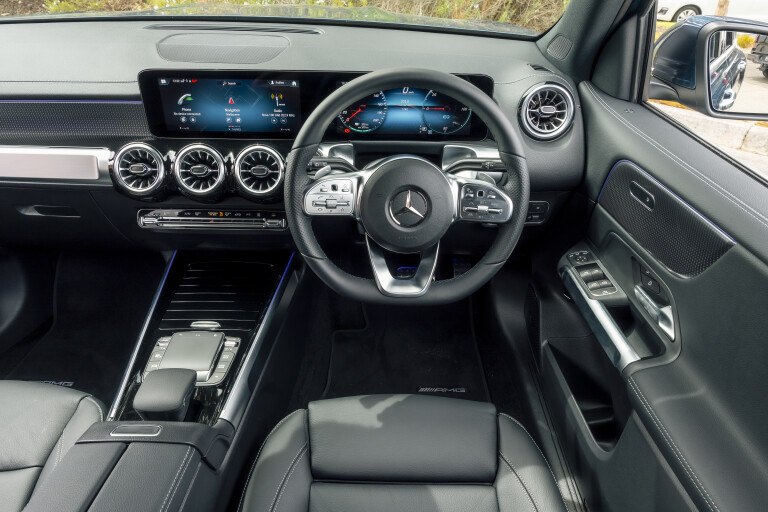
This is, of course, the polar opposite to the way the Californian upstart operates, and you get the impression that the EQB was built for the Mercedes-Benz customer who wants an easy transition into the oncoming electric era.
All control and interfaces function just as you would expect, it rides with polish and, with admirable real-world charge testing results, would be a genuinely nice EV to live with.
Amongst our megatest pool, Benz’s SUV BEV also offers the unique possibility of seven-seat packaging, for a cost-optionable $2900.
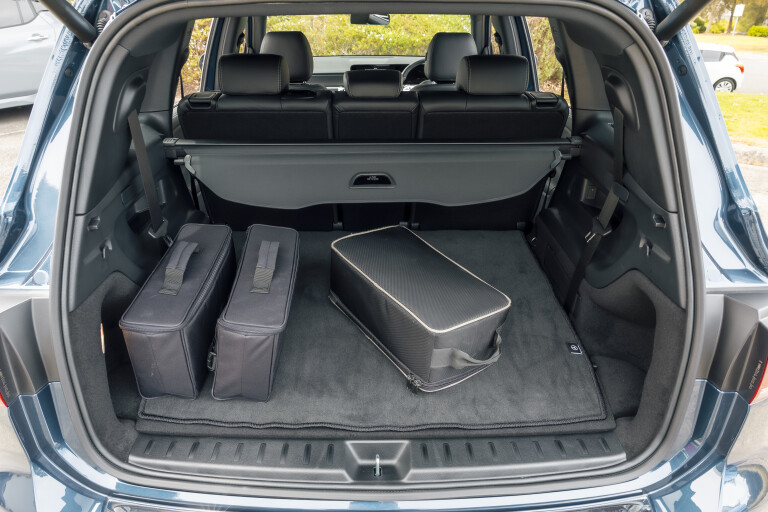
This is a genuine point of difference, however buyers-to-be should note that the third row suffers heavily limited legroom, and in practical use cases will likely only cater for the comfortable transport of small children. We attempted to fill the EQB with seven fully-grown motoring journalists on our delirious late-night cover shoot. The results were comical, to say the least.
Presentation and standard equipment is well-catered at this higher pricepoint, with an impactfully presented cabin impressing instantly with an ultrawide screen display centrepiece (made up of two 10.25-inch displays).
You also net 19-inch alloy wheels, heated front seats, keyless entry and start, DAB+ radio, satellite navigation, wired Apple CarPlay and Android Auto, LED headlights and an extensive suite of both passive and active safety systems as standard.
In five-seat configuration, the EQB250 boasts a claimed boot capacity of 495L, dropping to 465L with the third row optioned. With the third row of seating engaged, as expected, boot space is heavily impacted and drops to 110L. Unlike some, there is no under-bonnet storage.

As a car to drive, the EQB is familiar, feeling much like its combustion-powered relatives but with the extra smoothness and thrust of an electric powertrain.
It disguises its weight well, with supple damping and an excellent ability of ironing out ruts and road imperfections. Larger bumps, however, can see the body wafting and rocking for lingering moments. Standing acceleration by default is brisk, but unhurried, with a relaxed power delivery and throttle calibration, less a light switch, more the slow rolling of a potentiometer.
Steering is well matched to the vehicle, with accurate feedback and an agreeable 11.7m turning circle - resplendent at full lock with that hallmark Mercedes-Benz inner front wheel ‘hop’.
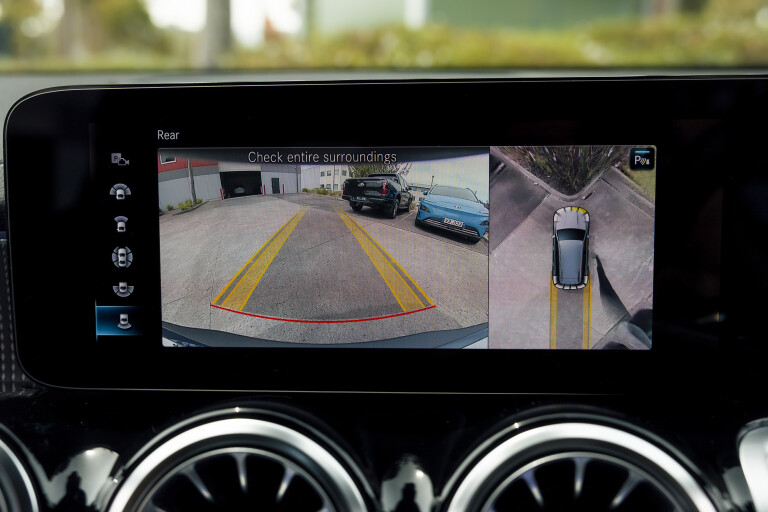
Despite weighing a touch over 400kg more than an entry GLB200, the EQB250 disguises its weight well in most road scenarios, though can feel top heavy at times in corners, with a taller centre of mass than the smaller EQA.
An average charge rate of 51.2kWh at the end of our range testing day saw the EQB replenish 32.4 kWh in 38 minutes, within a whisker of the popular Teslas, but slower than the 800v Koreans.
The EQB receives Mercedes-Benz’s five-year/unlimited-km warranty, with servicing intervals running annually or every 25,000kms.
SCORING: Mercedes-Benz EQB 250
| OVERALL | 7.8 |
|---|---|
| Safety, value and features | 7.5 |
| Comfort and space | 8 |
| Engine and gearbox | 8 |
| Ride and handling | 7.5 |
| Technology | 8 |
Specifications
| 2023 Mercedes-Benz EQB250 | ||
|---|---|---|
| Price | $87,800 + on-road costs | |
| Size & segment | Medium SUV | |
| Seats | 7 | |
| Boot space min/max | 110L/465L | |
| Drive | single-motor FWD | |
| Battery size | 66.5kWh | |
| Outputs | 140kW/385Nm | |
| Efficiency | 16.47kWh/100km | |
| Driving range | Claimed | Tested |
| 507km | 404km | |
| Charging speed | Claimed | Tested |
| DC fast charging | 100kW, 10-80% 30 min | 51.23 kW, 53-100% 38 min |
| AC home charging | 11kW, 10-80% 246 min | not tested |

2023 Mercedes-Benz EQA 350
The latest addition to Benz’s baby EV range is the more powerful EQA 350 – it gets double the grunt, 400km driving range and a plush ride
A note on the EQA's price
At the time of launch, and assessment, the EQA 350 was priced from $96,900 before on-road costs. It has since increased to $101,800 before on-roads. We're keeping it in this list for now, but it will likely shift to a future $100k+ high-end EVs guide.
| THINGS WE LIKE | NOT SO MUCH |
|---|---|
| In-cabin technology | Brake pedal feel |
| Plush urban ride | Rear seat comfort |
| Comfortable seats | Awkward regen braking |
The Mercedes-Benz EQA range is now headlined by the $101,800 (before on-road costs) twin-motor 350. It’s over $20K more than the base EQA 250, despite having the same 66.5kWh lithium-ion battery pack. You do get electric seats, a sunroof, and other goodies inside, though.
The EQA 350 produces 215kW/520Nm, which makes for a solid punch when the right pedal is pressed – the claimed 0-100km/h time of 6 seconds feels accurate – without churning one’s stomach as the twin-motor Volvo XC40 does.
There are four modes for regen braking selectable using the paddles in the EQA with ‘D-’ being the strongest, however no mode slows the car as smoothly as Tesla’s one-pedal setting. The EQA’s brake pedal is also spongy under foot. A nice inclusion is the EQA’s ‘D Auto’ regen mode which uses the radar sensor to automatically adjust regen strength and maintain distance to the car in front.
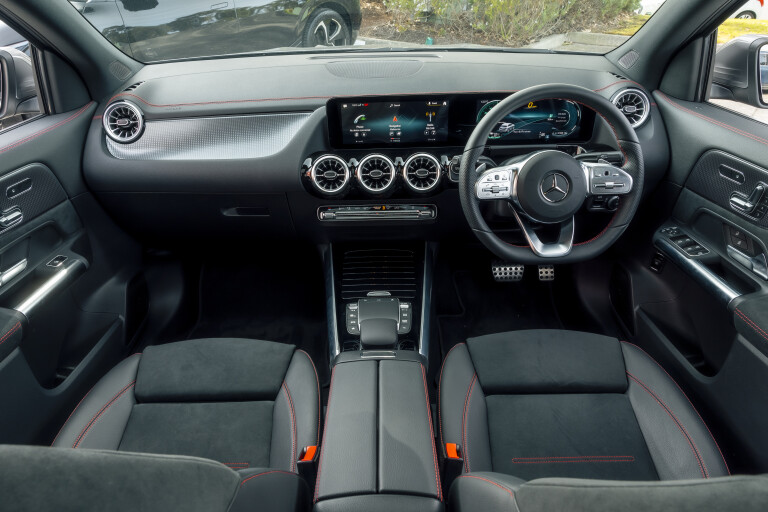
The EQA 350 is quiet and refined at low speed, and continues that trend right up to the national speed limit. Suspension noise is also better suppressed than in the EQB, perhaps owing to the more hatch-like body shape.
Ride quality around town is superb even on the intricate 19-inch alloys. The EQA is decidedly not an AMG model, and its two-stage damper’s Comfort mode reflects that with loose body control and plenty of suspension travel to soak up bumps.
On the country portion of our loop, Comfort introduced too much body lean. Sport was helpfully firmer, but the addition of a middling Normal setting would be nice.

Mercedes-Benz’s cabin architecture and styling is in a consistent place at the moment, at least in Australia. Shedloads of customisable ambient lighting, a mix of brightwork, piano black and red trim features for an ostentatious vibe. It’s very different from the unadorned, mid-century inspired disruptors like Tesla, and some will really enjoy that.
The 10.25-inch touchscreen blends into the digital driver’s display, both of which are customisable and responsive. Only the lack of wireless smartphone mirroring was a bit of a bugbear, but thankfully Benz uses fast-charging USB-C points throughout the EQA’s cabin.
Seating is taken care of by comfy and supportive power adjustable chairs appointed in a mix of ‘Microcut’ suedecloth with Artico bolsters and three-stage heating.
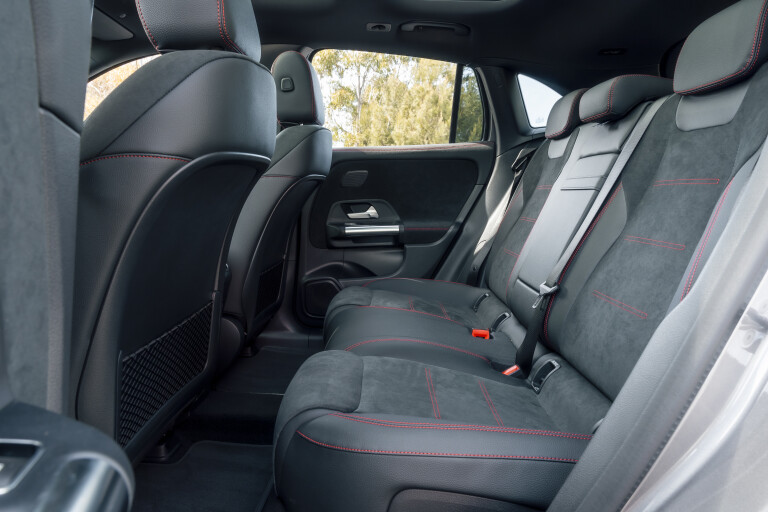
The rear seat is as expected for a hatch-styled small SUV, not generous for headroom but knee room excellent. The batteries mean that the floor sits higher though, so under-thigh support is lacking. Also, the black headliner, upholstery and tinted windows makes the rear seat quite dark. There’s always the airy EQB for those after more space.
With a 66.5kWh lithium-ion battery pack, the EQA 350 has a rated 400km driving range in the WLTP combined cycle. On the Wheels loop the EQA finished with 44 per cent charge remaining, and took 38.92kWh from the charger for a 19.65kWh/100km efficiency figure. That gives the 2023 Mercedes-Benz EQA a real-world driving range of 340km.

The EQA will take on DC electricity at a rate of 100kW, for a theoretical 10-80 per cent SOC time (34-272km range) of 30 minutes. From 44-100 per cent, the average rate was 64.86kW/h – one of the highest on test.
The Mercedes-Benz EQ 350’s limited range and high price make it a little more difficult to recommend as your only vehicle. The more affordable single motor EQA 250 with some choice options is probably the better buy for most. With reasonable range, quick charging and plush ride, the EQA 350 is a solid urban EV.
SCORING: Mercedes-Benz EQA 350
| OVERALL | 7 |
|---|---|
| Safety, value and features | 7 |
| Comfort and space | 7 |
| Engine and gearbox | 7.5 |
| Ride and handling | 7 |
| Technology | 8 |
Specifications
| 2023 Mercedes-Benz EQA 350 4Matic | ||
|---|---|---|
| Price | $101,800 + on-road costs | |
| Size & segment | Small SUV | |
| Seats | 5 seats | |
| Length/width/height/wheelbase | 4463/1834/16197/2729mm | |
| Boot space min/max | 340L/1320L | |
| Drive | Dual-motor AWD | |
| Battery size | 65.5kWh | |
| Outputs | 215kW/520Nm | |
| Efficiency | 19.65kWh/100km | |
| Driving range | Claimed | Tested |
| 400km | 340km | |
| Charging speed | Claimed | Tested |
| DC fast charging | 100kW, 10-80% 30 min | 64.8kW, 44-100% 36 min |
| AC home charging | 11kW, 0-100% 7h 15 min | not tested |

2022 Lexus UX300e
Lexus was surprisingly late to the EV party considering its hybrid history. Is the UX300e electric small crossover a sign of more pioneering to come?
| THINGS WE LIKE | NOT SO MUCH |
|---|---|
| Smooth driving manners | Poor driving range |
| Smooth performance | Limited rear seat space |
| Front-seat comfort | Weak regen braking |
| Complimentary charging for 3 years | Major update coming in 2023 |
Don’t buy a UX300e. Not yet, anyway. Lexus’s first fully electric vehicle is certainly not beyond recommendation, but a major update coming in 2023 is hard to ignore.
The first update since the UX300e was released in late 2021 will bring a bigger battery that addresses one of the current model’s biggest weaknesses: a lowly 315km WLTP range.
Based on our real-world testing, the Lexus wouldn’t make 300km.

A significantly improved range of 450km will take it past one direct rival in this same Megatest and closer to another: respectively, the Mercedes-Benz EQA (426km in 250 guise) and Volvo XC40 Recharge (510km).
Lexus says the UX300e will also benefit from a stiffer body and revisions to the steering, suspension, and brakes.
The hope is that the bigger and inevitably heavier battery and those other changes don’t greatly alter the UX300e driving experience because there’s much to appreciate about how it currently drives.
Exhibiting one of the finest urban rides of any EV in our Megatest, the electric UX’s suspension combines suppleness and absorption without detriment to wheel control. (Our tester was the top-spec Sports Luxury that sits on 18-inch wheels.)
It’s also impressively quiet thanks to both lined wheel-arches and its eco tyres (which are wrapped around 18-inch wheels on the Sports Luxury we had; 17s are fitted to the Luxury).
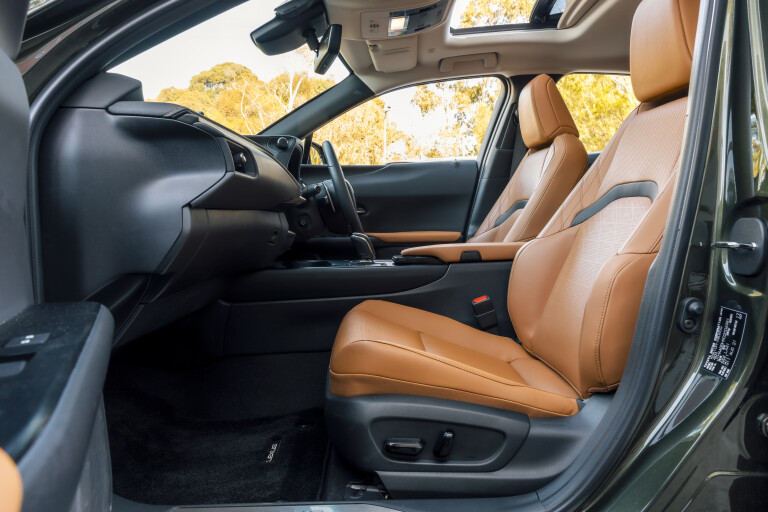
The leather-accented seats are supple and comfortably bolstered (and look quite posh in tanned Ochre), with electric adjustment on the front seats making it simple to find the perfect position.
Provided you’re not after the high seating position associated with SUVs. The UX not only looks like a hatchback in shape, it feels more like one from behind the wheel.
If there’s a quaint calmness to the way the UX300e rides and steers, it’s matched by the relaxed and linear nature of the performance delivered by electric drivetrain.
Outputs of 150kW and 300Nm from the sole electric motor up front are relatively modest, though the UX300e accelerates with a briskness that will satisfy plenty.
From previous testing in the wet, however, we know the UX300e is prone to wheelspin and torque steer.

Drivers have the option to flick a stubby switch to the side of the instrument binnacle to cycle through Eco/Normal/Sport modes; we quickly appreciated the default Normal more than suffices.
Pulling the paddleshift levers adjusts the regen braking through four levels, though the gearlever needs to pulled back from D to B to take permanent effect – and even the strongest setting is too mild to offer one-pedal driving.
A touchpad next to the gearlever provides finger-sliding and finger-prodding interaction with the UX’s infotainment system. It makes menu and function selection a fiddly exercise, especially when driving, and we won’t miss it when the updated UX300e brings a touchscreen that’s larger and closer to the driver.
Kids are likely to be happier than adults in the relatively cramped rear seat. Toeroom is particularly tight and access through the rear doors is quite narrow.
Boot space is below average at 314 litres and, unlike the XC40, there’s no storage ‘frunk’ under the bonnet.
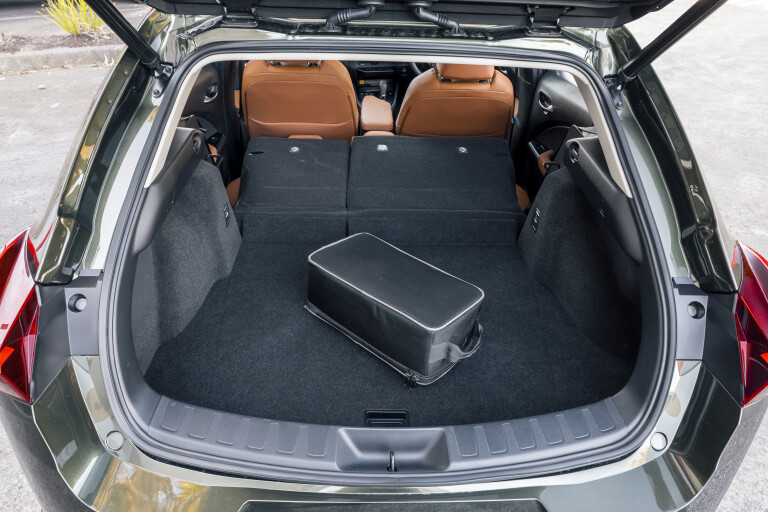
Equipment levels are decent. Common to both the $74,000 Luxury and $80,691 Sports Luxury are electric seats, wireless charging, heated seats front and rear, heated steering wheel, and a Mark Levinson audio. The more expensive UX300e adds bigger wheels, moonroof, head-up display, panoramic view monitor, and leather-accented leather over ‘Nuluxe’ pseudo leather.
Lexus throws some extra ownership bonuses into the equation besides a five-year warranty: the electric crossover comes with a free AC faster charger for home garages as well as three years of complimentary charging (via the Chargefox network) and benefits membership (Lexus Encore).
When a full charge brings that longer range promised by the bigger-battery MY23 UX300e, Lexus’s first electric car will be much more appealing.
SCORING: Lexus UX300e
| OVERALL | 7 |
|---|---|
| Safety, value and features | 7 |
| Comfort and space | 7 |
| Drivetrain | 7.5 |
| Ride and handling | 8.5 |
| Technology | 7 |
Specifications
| 2022 Lexus UX300e Sports Luxury | ||
|---|---|---|
| Price | $80,691 + on-road costs | |
| Size & segment | Compact SUV | |
| Seats | 5 | |
| Boot space min/max | 314L | |
| Drive | Single-motor FWD | |
| Battery size | 54.4kWh | |
| Outputs | 150kW/300Nm | |
| Efficiency | 15.27kWh/100km | |
| Driving range | WLTP | Tested |
| 315km | 294km | |
| Charging speed | Claimed | Tested |
| DC fast charging | 10-75% 50 min | 27.1kW, 29-100% 67 min |
| AC home charging | 240V (32A), 10-80% 6.5 hours | not tested |
VERDICT
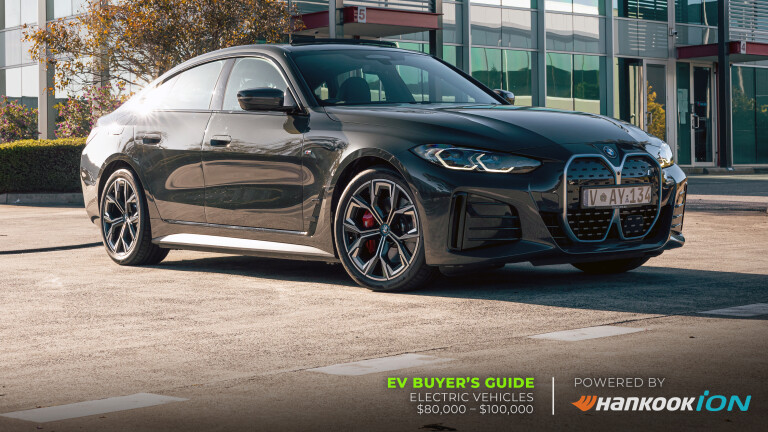
BEST BUY: BMW i4
HIGHLY RECOMMENDED: Volvo C40, Mercedes EQB250
The BMW i4 takes top honours in this segment. Engaging dynamics are its primary attraction, courtesy of sharp steering and an excellent ride/handling compromise, but it also overachieved in our charging and range tests. It was the second quickest car to charge (behind only the Tesla Model 3) and its theoretical real-world range of 513km was the highest of our group.
A lofty $99,900 price tag and no ANCAP rating are chinks in its armour, but keen drivers looking for an EV that’s fun to drive won’t be disappointed.
Volvo’s stylish C40 swoops into second place. With 300kW/660Nm on tap and a 0-100km/h claim of 4.7 seconds, it’s a wolf in sheep’s clothing that also offers a cleverly packaged cabin, a decent boot, and an impressively long list of standard equipment.
There’s a price to pay for its performance, though: it had the highest consumption figure of our group at 21.4kWh/100km.
The Mercedes-Benz EQB250 rounds out the podium. It’s currently the only seven-seat EV you can buy in Australia and its flexible cabin and sheer sense of space are its core strengths. Its third row of seats are a $2900 cost option, however, and its heavy-handed regen braking was one of the most unintuitive on test.
But if space, a sliding second row, and the ability to seat seven are your priorities, the EQB250 delivers.

COMMENTS